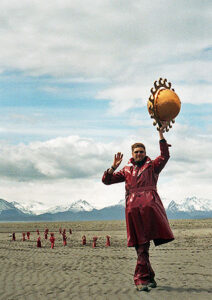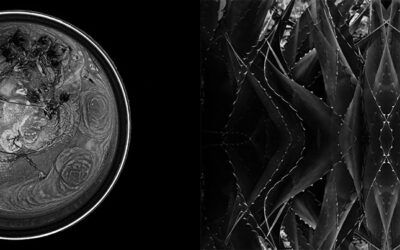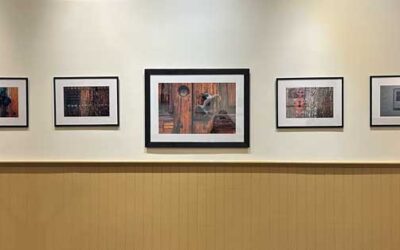 LOOK AGAIN
LOOK AGAIN
Look Again: An impressionistic interpretation of the site-specific performance project Look Again 2002. At the core of the project is the notion of transition, cycles of change, the beauty of the landscape, question of survival and what remains. Look Again is a 22 minutes short film winner of the Snow Dance 2005 international Film Festival in Anchorage Alaska. Produced and Directed for Alejandro IV Barragan.
Professor Dr. Jill Flanders Crosby of the University of Alaska Anchorage Department of Theatre and Dance received a grant from the National Endowment for the Arts (The National Choreography Initiative) to bring nationally recognized director/choreographer Brian Jeffery of Chicago to Alaska. In collaboration with community partners from Anchorage, Fairbanks and Homer, Jeffery has directed a project of site-specific movement based performances, which interpret the stories of five critical landscapes in diverse Alaskan communities.
LOOK AGAIN pioneers the development of dance in Alaska as a resource to critical contemporary discussion on site-specific art. We believe that the six selected sites: Ship Creek, Coastal Trail, Mud Flats, 5th Ave & C Street Lot in Anchorage, Chatanika Gold Dredge in Fairbanks and Bishop’s Beach in Homer, have all experienced critical states of transition. Whether affected by natural ecological erosion, industrialization or urban reclamation, these histories become visible as evidenced in the scars remaining on the landscapes. Referencing and interpreting industrial history, environmental evaluation, ecological impacts and aesthetic significance, this project invites multi-layered query and proposes different stories for each particular site.
The creators of the LOOK AGAIN Project have teamed with artists, historians, architects, scholars, writers, and performers to develop a multi-disciplinary experience. Incorporating dance and installation into the Alaskan landscape with related lectures, presentations and performances, suggests a constellation of perceptions, a reservoir of many stories and simultaneous truths. Also implicated in this project are design and the landscape, revisionist storytelling and dance as mediator for contrasting perspectives.
Homer / Bishop’s Beach
June 1, Saturday Site-Specific Performance: Go, and become lost in time
Time: 2-4:30pm
The place that transforms, the place that cleanses, the place that reveals, the place that waits, the place that endures. A movement performance will interact with the landscape at Bishop’s Beach during low tide.
Asia Freeman, Bunnell Street Gallery, offers a site perspective
Bishop’s Beach has seen the turning of many tides in Homer. A natural “harbor” on the north side of Kachemak Bay, Bishop’s Beach welcomed small boats during the warmer months of the year, starting around 1900 when no port existed at the end of the Spit. Boats entered Beluga Slough at high tide though the slough’s shallow mouth at Bishop’s Beach, anchoring in the slough’s sheltered waters. Many fox pelts from nearby fox farms, loads of coal, building supplies and the occasional mail-ordered bride landed on Bishop’s Beach, enroute to market or a remote homestead on Kachemak Bay.
Due to its easy accessibility, Bishop’s Beach is still frequented by locals and visitors alike. After Homer’s port was built in the mid 1900’s Bishop’s Beach’s main attraction was its coal. When storms tossed up coal from the bay’s rich seams, locals came out to gather it to warm their homes. Today folks are still driving down to Bishop’s Bach to enjoy the stunning panorama of Katchemak Bay while gathering coal, riding horses or walking on its wide sands, a perfect pedestrian park in all seasons. One of the most favored beaches in Alaska, Bishop’s Beach was named after George Bishop who in the 1960’s and early 70’s owned The Inlet Trading Post, now home to Bunnell Street Gallery, near Bishop’s Beach.
Anchorage / Mud Flats
June 12, Wednesday Site-Specific Performance: Beautiful Danger
Time: 5-7pm
A movement performance off the Coastal Trail near Lyn Ary Park at the threshold of the Mud Flats.
Writer Debra McKinney offers this site perspective
The coastal mud flats are the sirens of the city. Gleaming and seductive, they beckon wanderers out onto forbidden land. Many can’t resist. They venture out in rubber boots with binoculars, their dogs and an eye out for returning tides. Extreme beach combing you could call it. Rescue workers hold their breath. The wiser wanderers are careful how and where they step. Water-saturated mud is temperamental. Tiny grains of interlocking silt and sand can turn solid ground to jelly with the stomp of a foot. The weight of a step can displace water between the grains, which then lock together, seizing the ankle. The more the wiggling, the tighter the grip. And then in comes the tide. These mud flats can and have snatched people. At least two they haven’t given back. Danger and beauty. It’s hard to stay away. The seasons have their say in that. In winter, gnarled blocks of ice document the restlessness of the flats, making it obvious it’s no place to be. But in the summer, a peach fuzz of green and cloudbursts of shorebirds line its edges. It seems as though you could walk forever. And the tides put on such an amazing show. Turnagain Arm tides are among the most dramatic in the world, with a bore tide often rushing in as a wall of water several feet high. Surfers have surfed it. Kayakers have kayaked it. With beluga whales wandering in and out of the channels, wndsurfers have found themselves riding among waves of whales. The mud flats give such mixed messages. Come, they say. No, too dangerous. Stay away. A city’s forbidden front door.
Anchorage / Coastal Trail
June 15, Saturday Site-Specific Performance: Stillness, and the moment that followed
Time: Noon-3pm
Look up. Clouds scud across the sky. Look near. The curled tip of that leaf. Look down. Terra firma, dirt, rock and clay. Look again, your footprint, your mark, the impression that you left. Performers as living installations will interact with the landscape at numerous points along the Coastal Trail between Earthquake Park and Westchester Lagoon.
Dr. Genie Babb, Chair, UAA English Department, offers a site perspective
The Coastal Trail: a simple, prosaic name for such a variegated and dynamic experience. Unlike the other performance sites, the Coastal Trail is less a place than a journey: to experience even the shortest segment of its ten-mile length, you have to travel it-which means shifting perspectives, ups and downs, turning points, surprises, all punctuated by moments of stillness and reflection. Accessible year round, the Coastal Trail opens upon ever-changing vistas south along Cook Inlet, west to Mt. Susitna and Fire Island, and north to interior Alaska where Denali towers at 21,000 feet. The Trail beckons with glimmering views of downtown Anchorage and tantalizing glimpses into deep boreal forests and wetlands. Railroad tracks accompany it for a mile, float planes and commercial jets fly overhead. You can hike it, run it, bike it, ski it, and “walk the dog” it.
Just as there are many different trailheads along the Coastal Trail, so there are many entry points into understanding and appreciating the journeys of the Trail. The geologic perspective, for example, is a journey back in time half a billion years to a vast expanse of ocean; fast forward several hundred billion years and the ocean has become a “great valley drained by the ancestral version of the Susitna River,” as Anne Pasch, UAA Professor Emeritus of Geology, tells us. “The vegetation flourishing along the margins of these streams included lush forests … exotic mammals lived in this subtropical paradise.” It was only a few thousand years ago, at the end of the last Ice Age, that the topography that we recognize now as the Coastal Trail was formed — the most radical change added as recently as 1964, in the Great Alaska Earthquake.
Another “trailhead” for understanding is the human history that has shaped the Trail. Originally settled by Eskimo several thousand years ago, later populated by the Dena’ina Athabaskan as early as 500 CE, the area witnessed the first Europeans in 1778 with the landfall of Captain Cook. Having already claimed the territory by virtue of their trading activities, the Russians took it upon themselves to sell this great land to the United States in 1867 for $7,200,000. In 1915, Anchorage was founded, and in the 1980s the Coastal Trail was created as a result of strong oil revenues. Our personal journeys on the Trail, where no two moments are the same, carry within them the vestiges of these other journeys.
Fairbanks / Chatanika Gold Dredge #3
June 22, Saturday, Summer Solstice Site-Specific Performance: Dig Here
Time: 3-6pm
Location: Chatanika Dredge #3, in Chatanika Valley
Scars in the landscape, scars on the body, the psyche, innumerable scars dug deeply, old scars, scars not yet apparent, scars that will be left with us forever. A movement performance will interact with the environment at Chatanika Dredge #3, a rare piece of antique industrial mechanical mining equipment floating in its own pond on 50 acres of unspoiled tailings.
Jane Haigh, Co-owner Chatanika Dredge Company, offers a site perspective
Fairbanks was one of the richest placer gold districts in Alaska following the discovery of gold in 1902. But the early mining boom was short, and the richest deposits were soon worked out. After completion of the Alaska Railroad in 1922, industrial giant United States Smelting Refining and Mining Co. began to purchase and consolidate individual mining claims in order to work the rich ground with a fleet of gold dredges. With capital from Boston, they built the 64-mile Davidson Ditch, hydraulically stripped thousands of cubic feet of overburden, and began an extensive program of cold water thawing. By the late 1930’s the company had eight dredges operating in the Fairbanks area. The annual value of gold production in Alaska averaged $24 million, surpassing the record earnings of the early gold rush. Dredge Number 3, arrived on the Tanana Valley Railroad in pieces in the spring of 1927, and was constructed not far from where it stands today. It continued to work the Cleary Creek and Chatanika River gravels until 1963.
Anchorage / 5th Avenue & C Street Lot
June 7, Friday Site-Specific Performance: Urban Memory Forest
Time: 4:30-7pm
A movement performance will take place in and around the Urban Memory Forest, a site-specific installation developed by Klaus Mayer and Petra Sattler-Smith of Alaska Design Forum with Look Again director Brian Jeffery. Urban Memory Forest anchors the Look Again Project at 5th Ave & C Street, consisting of metal pilings erected to reflect this particular sites environmental history, the installation is a tangible meditation on a boreal forest. From June 3rd-21st Urban Memory Forest will act as a point of departure for other events surrounding Look Again, evoking questions concerning what we have lost, what we remember, and what remains in our contemporary environment.
Dr. Genie Babb, Chair, UAA English Department, offers this site perspective
Picture the vacant lot at 5th and C. Not easy, is it? A vacant lot by definition is void, empty. You can picture the streets and landmarks that surround it-the 5th Avenue Parking Garage and YWCA to the north, the 5th Avenue Mall to the west, the handful of small shops in frame houses to the east, a Community Service Patrol Transfer Station to the south. But to picture the lot itself taxes the memory. A vacant lot is negative space known only by what frames it, not for what it is itself.
Of course, these frames are modern impositions, as old as Anchorage itself, which was founded as a “Tent City” in 1915 to headquarter the building of the Alaska Railroad. Before that, the lot was far from vacant; in fact, it was part of the vast circumpolar boreal forest that spans Alaska, Canada, Scandinavia, Northern Scotland, Russia, China, and Japan. Called the earth’s “emerald halo” or “green wreath,” this ecoregion comprises one-tenth of the planet’s total surface and one-third of its forested area, making it the world’s largest natural ecosystem.
Derived from the Latin “Boreas” god of the north wind, the boreal forest dates from the end of the most recent Ice Age. Its extreme climate and acidic soil hosting hardy spruce, fir, larch, alder, birch, and aspen. Water sources abound: rivers, lakes, fens, and bogs. Over 200 species of birds, along with mammals such as caribou, lynx, black bear, moose, beaver, wolverine, mink, hares, squirrels, and voles inhabit the boreal forest. And human beings? Eons before Captain Cook “discovered” the area in 1778, the pathless forest was traversed by first the Eskimo and later the Dena’ina Athabaskan peoples.
What remains of this ancient history on the site of the 5th and C vacant lot? Nothing but a memory. No visible trace of its Boreal forest grandeur. Only the ornamental trees and shrubs that line the sidewalks distantly allude to the birch and spruce that once inhabited the area. However, this forgotten, effaced, and erased natural history will be revivified this summer with the Urban Memory Forest installation. Will we ever look at this lot as “vacant” again?
Anchorage / Ship Creek
June 9, Sunday Site-Specific Performance: One Fish, Two Fish, Red Fish, Dead Fish
Time: 2-4:30pm
The beauty that fascinates and enthralls us within the cycles of survival, life, sustenance, death, rebirth, is not an end to itself. “Violence and life are virtually synonymous. The sprouting corn breaking through the icy soil, the sparrow’s beak piercing the shell of the egg, the impregnation of a woman, the birth of a child- all testify to violence.” -Jean Genet A movement performance will take place on the shores of the creek near the areas populated by fisherpersons during the Ship Creek Salmon Derby.
Writer Debra McKinney offers a site perspective
Ship Creek is a convergence of disparity, of wildness and heavy industry, where you can see a bear and bulldozer in the same blink. As the birthplace of Anchorage, this creek says more about our city and its values than any other local microcosm.
Before 1915, Ship Creek meandered freely across extensive tidal wetlands, disturbed only by the footprints of wildlife and the Native people who fished here. Once President Woodrow Wilson authorized funds to build the Alaska Railroad, 2,000 people descended upon its shores. The creek, channeled and dammed, now goes where it’s told.
Still, it provides a major recreational fishery and escape within the city. Ship Creek is a creek of contrasts. Fishers have found supper in these waters. Scientists have found minute traces of DDT. People have come to this creek for everything from writing poetry to dumping dead bodies.
Ship Creek seems to bring out the best and worst in urban humanity.
Yet something about it inspires the city’s visionaries like no other. Their dreams for its future run the gamut. Damming the creek to create a lake. Converting an old power plant into a natural gas fired generator. Building an aquarium, a private planetarium, shops, theaters, boutiques, restaurants, and trailways. Even raising the Orca, a 177-foot whaling ship that sunk in 1897 in the Chukchi Sea, and bringing it here as a museum with a Disney-style tramway to haul thousands of tourists.
And then there are those who’d like to put it all back. “Ship Creek Unplugged” is the Anchorage Waterways Council’s campaign to remove three of the creek’s lower dams, creating 12 miles of free-flowing water, and boosting wild salmon runs.
The dreams come and go. But for the past 87 years, Ship Creek has been in a constant state of transition, both real and imagined.




